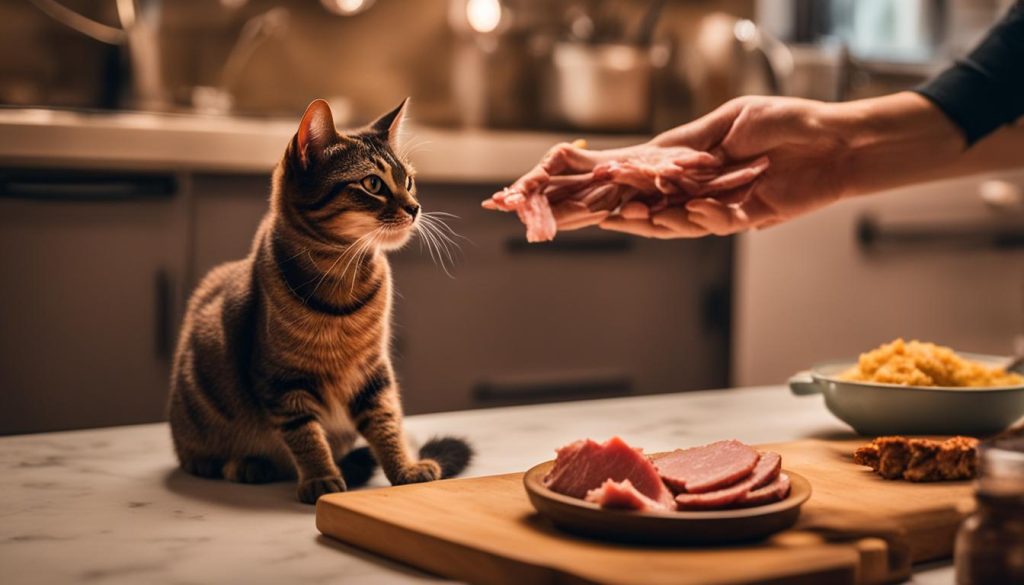I often find myself wondering if my feline friend can enjoy the same foods that I do. One question that frequently comes to mind is, “Can cats eat pork?” It’s important for pet owners to understand the implications of feeding their cats certain foods, and in this article, I will discuss the safety of pork for our furry companions. Let’s explore the topic together and ensure the well-being of our beloved cats.
Can Cats Eat Pork? Yes, technically they can.
- Plain, lean, and well-cooked pork is generally safe for cats in small amounts.
- Avoid giving cats processed pork, like bacon or ham, and pork with seasonings or sauces.
- Stick to lean cuts of pork, such as tenderloin or loin chops, without any added seasonings or sauces.
- Feeding pork to cats should be an occasional treat, following the 10 percent rule.
- Consult with a veterinarian for proper guidance on feeding your cat and to ensure their overall well-being and health.
How to Treat Your Cat to Pork
When it comes to treating your cat to pork, simplicity is key. Stick to plain, cooked pork for a safe and enjoyable experience for your feline friend. Here are a few ways to incorporate pork into your cat’s diet:
1. Boiled and Cut
Boil plain loin chops or tenderloin in water until thoroughly cooked. Then, cut the pork into small, pea-sized pieces. This method ensures that the pork is safe and easy for your cat to consume.
2. Porky Pops
Create tasty frozen treats for your cat by putting small bits of cooked pork in an ice cube tray. Pour cat-friendly broth over the pork and freeze until solid. Your cat will love the chilled porky pops!
3. Baked Pork Bites
If your cat enjoys a crispy texture, try making baked pork bites. Cut lean, plain pork into pea-sized pieces, place them on a baking sheet, and bake until thoroughly cooked and crispy.
Remember, these methods should only be used occasionally, as treats or rewards. Feeding pork to cats should not replace their regular well-balanced cat food diet. Additionally, if you prefer ready-made options, there are commercial cat foods and treats available that include pork as a primary ingredient.
Benefits of Pork for Cats
When fed appropriately, pork can provide a variety of benefits for cats. It is a high-quality source of protein, containing essential amino acids like taurine and arginine that support various bodily functions. Pork is also a good source of essential vitamins and minerals, including B vitamins, phosphorus, and zinc.
Many cats find pork to be delicious, which can add variety to their diet and entice picky eaters. Pork can also be used as a high-value treat to motivate cats to follow commands or practice new behaviors.

Risks of Giving Pork to Cats
While pork can offer some benefits when given as an occasional treat, it is important to be aware of the potential risks involved. Feeding cats pork that is undercooked or raw can expose them to harmful parasites, such as roundworms. These parasites can lead to digestive disturbances and muscle inflammation in cats, compromising their overall health and well-being.
Pork bones, especially once cooked, pose a significant danger to cats. They can splinter easily and present a choking hazard or cause blockages in the cat’s digestive tract. It is crucial to avoid giving your cat pork bones to keep them safe and prevent any potential harm.
Moreover, certain seasonings and spices commonly used in pork preparation, such as onion and garlic, can be toxic to cats. These ingredients can lead to various adverse effects, including gastrointestinal upset and, in severe cases, damage to the red blood cells. It is essential to avoid seasoning pork with anything that could be toxic to cats.
Processed pork products may also contain preservatives that can be toxic to cats when consumed in large quantities. These preservatives can have detrimental effects on their health and should be avoided altogether.
Lastly, regular consumption of pork, especially fatty cuts, can contribute to weight gain in cats and increase the risk of obesity-related health issues. Maintaining a healthy weight is crucial for a cat’s overall well-being and can help prevent a range of health problems, such as diabetes and joint issues.
How to Safely Feed Your Cat Pork
When feeding pork to your cat, it is important to do so in moderation. Most cats will only need 1-3 small pieces of pork, roughly the size of a pea or two, as a treat. Offering pork once a week or less is recommended. It is also advised to follow the 10 percent rule, where no more than 10 percent of your cat’s daily calories should come from treats or human food, and the other 90 percent should come from well-balanced cat food. Lean cuts of pork, such as tenderloin or loin chops, should be used, and the pork should be fully cooked and free of any seasonings, spices, or sauces.

Feeding your cat pork in the right amounts and manner is essential for their health and wellbeing. Remember to provide pork as an occasional treat, adhere to the 10 percent rule, and choose lean, fully cooked cuts of pork. By doing so, you can safely treat your feline friend to the occasional porky delight without compromising their dietary needs.
Alternative Meats for Cats
When it comes to feeding our feline friends, there are alternatives to pork that provide better nutrition. Two recommended options are chicken and fish.
Chicken: Chicken is a lean meat that offers cats essential amino acids and micronutrients. It is widely used in commercial cat food due to its bioavailability and health benefits. The nutrient ratio in chicken is favorable, with lower fat content compared to pork.
Fish: Fish, such as salmon or tuna, is another excellent alternative to pork. It contains essential fatty acids like omega-3 and omega-6, which contribute to a healthy coat and skin. Additionally, fish is easily digestible for cats and can be a good source of protein.
Both chicken and fish are staples in many cat food formulas and are readily available for regular feeding. These alternative meats ensure that our cats receive the necessary nutrients without the drawbacks associated with pork.
Conclusion
It is safe to give cats pork as an occasional treat. However, it should not be a regular part of their diet. When feeding pork to cats, it is important to stick to lean, thoroughly cooked cuts without any seasonings or sauces. This ensures the safety and well-being of our feline friends.
Pork offers cats benefits such as high-quality protein and essential vitamins and minerals. However, there are risks associated with feeding pork, including the presence of parasites, bone hazards, toxic ingredients, excessive salt intake, and the potential for obesity. These risks can be mitigated by offering alternative meats, such as chicken and fish, which provide better nutrition without the drawbacks of pork.
Consulting with a veterinarian is crucial when considering introducing pork or any other human food into a cat’s diet. They can provide proper guidance based on your cat’s specific needs and ensure their overall health and well-being. Remember to prioritize a well-balanced cat food diet for the majority of their meals to provide all the necessary nutrients for their optimal health.
FAQ
Can cats eat pork?
Yes, cats can eat pork, but it should be given in moderation and prepared appropriately.
Is pork safe for cats?
Plain, lean, thoroughly cooked pork is generally safe for cats in small amounts. Processed pork and seasoned or sauced pork should be avoided.
Can cats digest pork?
Cats can digest plain, lean, thoroughly cooked pork. However, they may have difficulty digesting fatty or processed pork.
What are the dangers of feeding cats pork?
Feeding cats undercooked or raw pork can expose them to harmful parasites. Pork bones can also pose a choking hazard or cause blockages in a cat’s digestive tract. Seasonings, spices, and preservatives in pork products can be toxic to cats if consumed in large quantities.
What are the benefits of pork for cats?
Pork is a high-quality source of protein, essential vitamins, and minerals that support various bodily functions in cats. It can add variety to their diet and entice picky eaters.
How much pork can I give my cat?
When treating your cat to pork, 1-3 small pieces, roughly the size of a pea or two, is sufficient. Pork should only make up a small portion of their overall diet.
How often can I give my cat pork?
Pork should be given to cats as an occasional treat, no more than once a week. The majority of their daily calories should come from a well-balanced cat food diet.
What are the alternative meats for cats?
Chicken and fish are commonly used in commercial cat foods and offer a better nutrient ratio with lower fat content compared to pork. These meats provide essential amino acids, vitamins, and minerals that cats need.






